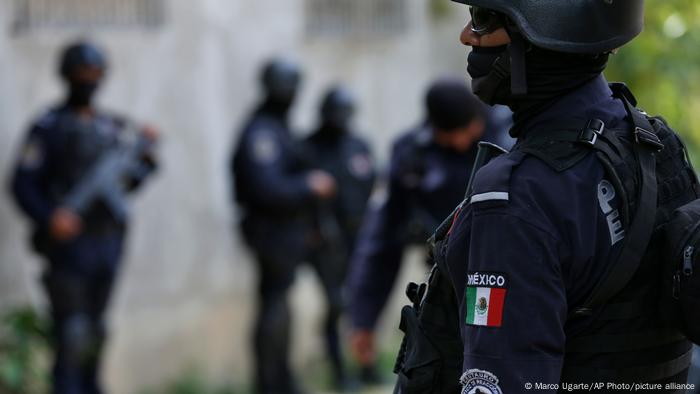Mexico has been left shaken by the fourth slaying of a journalist this year: Roberto Toledo was attacked and shot by three people in the city of Zitácuaro on Monday.
According to his boss Armando Linares, Toledo, who worked for local news portal Monitor Michoacán, had been receiving threats for months and was in a state protection program.
Linares said Toledo was killed over Monitor Michoacán’s role in exposing corruption in politics.
Mexico, along with India, was home to the highest number of journalists murdered in 2021, according to the Committee to Protect Journalists (CPJ). The organization Reporters Without Borders calls Mexico one of the most dangerous countries in the world for journalists.
The killings are a result of systemic problems that have worsened over the years due to growing impunity and the rise of drug trafficking.
Just a week before Toledo’s death, journalist Lourdes Maldonado was killed in the northern Mexican border city of Tijuana. A week before that, photographer Margarito Martínez was shot dead outside his home. Like Toledo, both had previously received threats and had informed the police. On January 10, José Luis Gamboa, the head of the platform “Inforegio” in the state of Veracruz, was stabbed to death by assailants.
In 2012, after pressure from civil society, a state mechanism was put in place in 2012 to protect journalists and human rights defenders. Those affected were thrilled. Colombia had been the first Latin American country to introduce such a mechanism. Mexico, Guatemala, Honduras, Brazil and Peru would follow. But though the program has indeed helped to save lives, it is overstretched and underfunded. At least 14 journalists who should have been protected by the program have died.
A flawed system
“The protection mechanism has many flaws and must be strengthened,” said Balbina Flores from Reporters Without Borders in Mexico. “When journalists are threatened and turn to the mechanism, emergency measures are supposed to be triggered within 12 hours. This usually entails providing a panic button or activating the local police force,” she told DW.
“But if somebody lives very remotely or in a very dangerous area, the decision might be made to remove them or to provide a bodyguard. […] Generally, it takes 15 to 20 days to put simple measures in place, but it can take up to half a year to provide a refuge or a bodyguard.”
Some 1,500 people, including 500 journalists, currently enjoy protection from the mechanism but the mechanism is under pressure. “The applications have risen by 60% since 2019. But the mechanism still has the same staff and almost the same resources as before then.”
Itzia Miravete, the prevention coordinator for the NGO Articulo 19 criticized the fact that the mechanism was purely reactive and had failed to coordinate with other federal agencies and to put in place an effective preventative unit. “It is not only the mechanism that has failed but the entire state because for years this mechanism was the only official protection program,” she says.
More funds and staff needed
The criticism from human rights organizations does seem to have found some resonance, and last year the Mexican Interior Ministry proposed a reform that would transfer responsibility for protecting journalists and activists to federal states. Though human rights organizations welcomed the move, Balbina Flores from Reporters Without Borders warns that it would be “very difficult to achieve results without economic support and professional staff.”
For her part, Itzia Miravete insisted that more political will was needed to implement the necessary changes, such as greater transparency, the participation of victims’ organizations, the awarding of damages, as well as the enforcement of sanctions against the authorities should these fail. “All of the prosecutors in the country have the standard protocol for prosecuting crimes against freedom of expression and are obliged to apply it,” she explains.
Distrust between press and politicians
One problem, however, is that there is a tradition of suspicion between journalists and the authorities, particularly because threats against journalists frequently come from the police or local politicians themselves.
For her part, Lourdes Maldonado had complained directly to Mexican President Andres Manuel Lopez Obrador that the threats against her emanated from a party colleague of his, Jaime Bonilla, the governor of the state of Baja California, against whom she had filed a labor lawsuit.
Even if there are some improvements to the state protection mechanism, it cannot work like magic amid a spiral of violence fueled by 96% impunity. “If the Mexican state really wants to improve conditions for the media, a much more comprehensive reform is needed,”Miravete says. “We could, for example, reform the laws that enable compensation suits that are aimed at silencing journalists.”
Mexico is a long way from having a comprehensive security strategy. Reforms to establish a more professional police force and ensure greater political independence for the judiciary have stalled. According to the World Justice Project, whose aim is to advance the rule of law around the world, Mexico dropped by nine places in its global index to 113 out of 139 states in 2021.
This story was originally written in German.
Editor’s note: This is an updated version of an article originally published on January 27, 2022.
Mexico’s press protection plan under pressure after 4 journalists die
Source: Pinoy Pop News

0 Comments